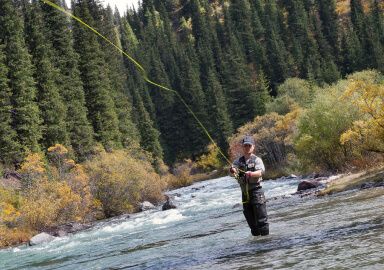Himalayan Mahseer
As exotic as the name: the Himalayan mahseer is a large freshwater fish that is the hero of many a tale about fishing in of the foothills of the Himalayas.
View 3 listings
3
listings
–
price starting from
1
countries
–
to the nearest trip
Where and When?
The golden mahseer is naturally found in the upper regions of the Indus, Ganges, Brahmaputra and other rivers exiting southwards from the Himalaya Mountains. Nepal is currently the top destination for mahseer fishing. Abundance, and particularly that of large specimens, has declined drastically due to fishing pressure, dam construction, pollution and development. On the other hand, they have been introduced to new areas and dams where there are suitable streams in which they can spawn.
The mahseer can be found in lowland areas, but there it’s usually small and far from numerous, due to fishing pressure and competition from other species. It is in inaccessible, high-altitude headwaters, where large individuals can still be located. In these turbulent areas the fish usually lie below or beside rapids and in the entrance or tail end of pools or areas of slower water movement. Fishing is usually a day-time activity and, although they can probably be caught throughout the year, winter conditions in the Himalayan foothills are quite extreme and most fishing is carried out in the summer months.
About Himalayan Mahseer
The Himalayan or golden mahseer (Tor putitora), is a member of the carp family. It is elongate, cylindrical and used to grow to a massive size. As the British colonials, skilled in fly fishing the rivers of England and Scotland, discovered mahseer, they pronounced it superior to even the salmon. Rudyard Kipling considered the tarpon “but a herring” compared to this species. Were it not for difficulties in accessing areas where it still grows large, it would be a highly popular sport angling fish.
The Himalayan mahseer has a large, smooth, head with a big mouth, rubbery lips and no teeth. The body scales are large, the eyes small and the upper regions of the body are golden, while the lower is more silver with a prominent, thick dark stripe down the lateral line. Golden mahseer can grow to 2.75 m. (9 ft.) with a mass of up to 54 kg. (119 lbs.) and, although fish of this size are now rarely seen, excellent specimens can still be caught in some remote areas.
The mahseer is omnivorous and predates mostly on other fish and invertebrates. The golden mahseer prefers cooler, turbulent, rocky and high energy areas of rivers, but can also be found in some slow flowing areas and even dams. They are generally not a shoaling species, especially as they become larger.
How to Catch?
The reason why golden mahseer are not a particularly well-known sport angling species is simply because of the difficulties, time and expense involved in getting safely to where good specimens can be located. The best approach is to book a tour, often as a part of an overland or rafting group, with a reputable guide or operator, as local knowledge of the areas, people, authorities and the fish, is critically important.
Fishing methods in the river headwaters are traditionally fly fishing, with strong tackle aligned for bigger flies and hard-fighting fish. Spinning equipment is a good alternative. In the remote areas the fish are quite naive, and a wide variety of lures, colours, and presentations will work. The capture of a good-sized mahseer is something very few sport anglers will achieve in their lifetimes but, if accomplished, it will be a truly wonderful memory.


